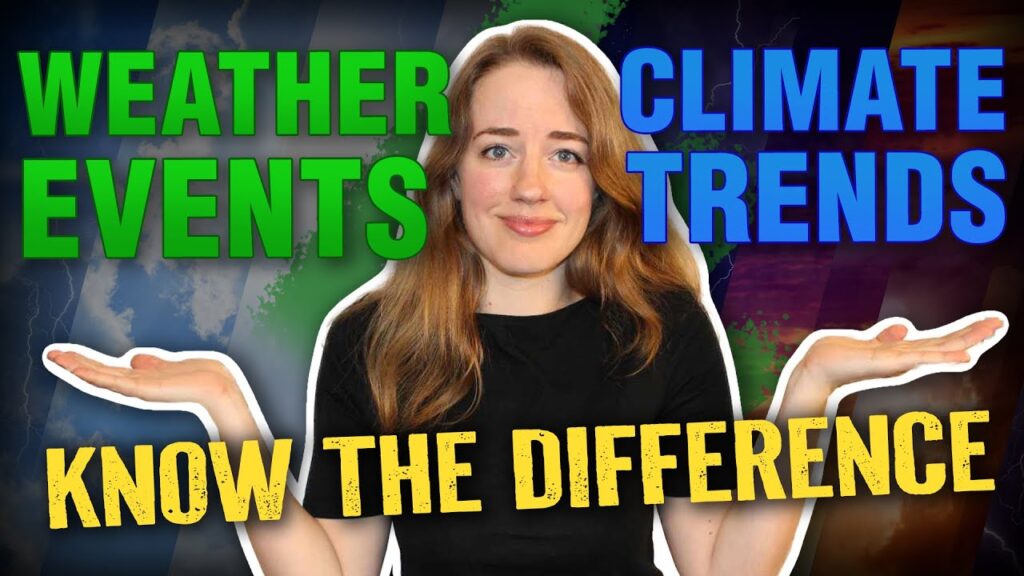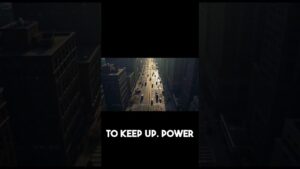
In this video, Linnea Lueken breaks down the often-misunderstood distinction between weather and climate. With media outlets and climate activists frequently misusing the terms interchangeably, this quick fact check aims to arm viewers with clear definitions to spot misleading claims about so-called “climate disasters.”
Weather is what we experience daily—sunshine, rain, storms—while climate is a long-term average over decades. Linnea highlights how cherry-picking extreme weather events to “prove” climate change misrepresents the data. In fact, long-term trends show little to no increase in storm frequency or intensity despite modest warming. So why are we told every storm is a sign of climate catastrophe?
Support this content 👉Donate – The Heartland Institute
https://heartland.org/donate/
Download a FREE copy of Climate at a Glance for Teachers and Students and get the app so you are never without resources to combat climate alarmism: https://climateataglance.com/app/
…Or help us out by purchasing a hard copy on Amazon: https://shorturl.at/deiKS
Watch Linnea every Friday LIVE at 1 p.m. ET on The Climate Realism Show. https://www.youtube.com/theheartlandinstitute
Check us out on Instagram 👉@HeartlandInstitute
We’re on Facebook 👉 The Heartland Institute
Follow Linnea on X 👉 https://twitter.com/LinneaLueken
Sources used for this video can be found here: https://climateataglance.com/climate-at-a-glance-weather-vs-climate/
source




Wasting your time.
The Climate Agenda gets them in preschool all the way to college.
That is reality for them. They are incapable of even considering any other evidence. Now they even have echo chambers and confirmation bias 24/7 on their apps.
The only chance would be a solar flare taking out all electronics.
Plants are thriving now that C02 isn`t dangerously low the way it was less than 200 years ago. Cold is our biggest danger and several natural events can and WILL cause it to happen again. Example? See 536 AD.
Even 30+ years is still a very short period of time, compared to the Earth's very old age.
Thanks again for the truth, I wish clips from Heartland Institute and Climate at a Glance, could be played at the UN and by every national broadcaster in Western nations.
What a shame that John Kerry isn't subscribed! But then again, what is being discussed here is truth. He can't have any of that. I suspect that Greta can't either. Thank you, Linnea!
😊
I love it how climate alarmists blame the once or two times a year when the temperatures hit record highs and then they blame it on climate change. Climate change refers to long term temperature changes, not when the temperatures climb for a few days then go back down to normal. That's caused by other factors, like the direction the wind is blowing, or the sun's peak in solar activity, like what happened in March of 2012 when the temperatures spiked in the Northern Hemisphere due to the x+10 solar flares and CMEs directed at the Earth over a span of 11 days from the 7th on. Traverse City Michigan reached a record temperature of 82 degrees. They blamed it on climate change when it had nothing to do with the climate changing. It was a fluke coincidence because the sun unleashed a 2.5 million degree solar wind full of hot charged particles directly at the Earth, which then absorbed into the upper atmosphere and then quickly dispersed into the colder air below, causing temperatures to climb to unseasonably high levels. The crazy thing is it happened almost 11 years later in march of 2022 and was caused by the sun's 11 year sunspot cycle, not climate change or global warming due to CO2. Climate alarmists are all ignorant for ignoring all the facts. CO2 can't heat up without the energy produced by sun!
As usual, great facts. So glad we have this information being given out! Beautiful job!
Thanks for the continual effort of saving us from the cult of Global Warming
Two thumbs up Linnea's report today.
There can be no legitimate discussion about climate anything without first and foremost including the effects of the on going climate modification programs being deployed globally, 24/7/365.
Those are not contrails, they are nano sized bio available aerosols. And you're breathing them 24/7/365, indoors or outdoors.
That jacket is still an abomination. lol
Beauty and brains. Love your work Linnea.
Too bad my local news doesn’t listen to the truths presented here
You need at least fifty years for a climate trend to stand out from weather noise and ocean oscillations, and thirty years to stand out from weather noise alone.
No one from mainstream climate science is telling us every storm is a sign of climate change or "climate catastrophy".
Well done, thank you Linnea!
Love these videos. Truth not scare tactics. Tu
Take away the subsidies and "their" climate change narrative will change very quickly 🙂 It's all about milking the taxpayer for trillions of dollars, which is the greatest wealth transfer ever. Thank you for great work!!
Desert climate, Arctic climate, Temperate climate, Tropical climate
I think 60 years, or more, would be a better minimum for climate analysis.
mark twain had it right when he said climate is what u want and weather is what u get. but then he wasnt on the gument dole
Over a long period of time=30 years? Surely that's just a short term trend and we have to look at a long time as being a geological timescale keeping past trends in mind when we look at the data?
Weather is real, climate is statistics.
A climate at a glance episode should be shown every morning in US grade schools, immediately after the pledge of allegiance.
They say it's warmer now than ever before, but we still can't live off agriculture in Greenland, which we could until the Little Ice Age hit in the 1300s.
Atmospheric CO2 above 100ppm (whatever the source ie man-made or not) makes next to NO difference to atmospheric temperature (due to the long established FACT that there is a log scale relationship between the two), meaning OTHER factors predominate…..(the left wing useful idiots will eventually adapt)…next topic.
Atmospheric CO2 has been falling more or less continuously now for 3.5-billion years, ever since carbon-based life first began. Before life emerged CO2 was around 700,000-ppm but every year living organisms have died, fallen to ground or seabed and every year some get buried and fossilised, permanently removing carbon from the biosphere. As a result 99.99% of atmospheric carbon has now been absorbed into the rocks of the lithosphere. This process continues today and when CO2 eventually falls below 150-ppm photosynthesis will stop working and all life on Earth will end. The climate change movement is a Death Cult, trying to accelerate this decline by using carbon-sequestration schemes to bury more CO2 underground; they are trying to destroy all life. Restoring fossilised CO2 back into the atmosphere from coal, oil and gas to delay extinction is Humanity’s greatest achievement. Click above to see more.
– We live in the same climate as it was 5 million years ago –
The cause of climate change is that the Earth is in travel to the deep past since May 10, 2010.
Each day starting May 10, 2010 takes us 1000 years to the past of the Earth.
Today April 01, 2025 our Earth is at the point 5 million and 440 thousand years in the past.
On October 13, 2026 our Earth will be at the point 6 million years in the past.
On September 25, 2037 our Earth will be at the point 10 million years in the past.
On April 02, 2147 our Earth will be at the point 50 million years in the past.
On April 26, 2188 our Earth will be at the point 65 million years in the past.
The result is that the Universe is heading back to the point where it started and today we live in the same climate as it was 5 million years ago.
Little lies of omission. No, storms have not increased. But they have grown more intense. A NOAA study finds that while caegory 1 and 2 hurricanes have decreased, category 3, 4 and 5 storms have increased, with an 8% bump up in intensity every decade for the last four decades. A Taiwanese study of typhoons shows the same increase in intensity. Arctic cyclones too.
The UN should be disbanded. They are corrupt and dangerous. Anyone with a functioning brain knows the “climate crisis “ is about control of the population and not about saving the planet.
I just scraped ice off my car wind screen on the 1st of April. Must be Global Boiling. 😂
Always the voice of reason. Thanks Linnea.
Thank you for putting this out for the world to see.
Weather (less than 30 years); Climate Change (more than 30 years); Anthropogenic Climate Change (Human Industrialization – min 100 years)
Hurricanes and tornadoes were more frequent, and stronger in the 1930s.
It's never been about anything other than power and control.
And according to Wikipedia and the UN, “Human activities have been the main driver of climate change…” Really? Over the last four billion years climate never changed? Until humans started burning gasoline and coal? Just three hundred years ago? How can anyone believe this crap?
The weather prognosticators/alarmists are the same folks who couldn’t forecast correctly a week in advance if their life depended on it. A forecast in Feb for a warmer than normal Spring has turned just the opposite in many areas.
Can you talk to Trudeau please. Better yet, the Liberal/NDP/Green/Bloc party's in general. Some of the conservatives too.
Go Linnea. Go Heartland Institute! Truth will out in the end.
The crisis is climate scammery
*Synthesis: A Dialectical Framework for Sociocratic Communism*
The capitalist mode of production, underpinned by Keynesian demand management and neoliberal financialization, operates as a self-replicating system of accumulation that externalizes ecological and social costs. Its structural dependency on infinite growth, debt issuance, and labor exploitation generates crises of overproduction, inequality, and environmental collapse. In contrast, the proposed sociocratic-communist framework synthesizes decentralized governance, dialectical materialism, and regenerative economics to transcend these contradictions.
—
### *I. Sociocratic Governance: Structure and Dialectics*
Sociocracy is a nested, fractal governance model that embeds *dialectical processes* into decision-making. Its architecture consists of autonomous, self-governing circles (e.g., worker cooperatives, community assemblies) linked through **double-linking**—a delegate from each circle participates in higher-tier circles, ensuring bidirectional feedback between local and systemic priorities.
1. **Consent-Based Deliberation**:
– Decisions require *consent*, defined as the absence of reasoned objections. This mirrors the scientific method’s iterative hypothesis-testing:
– **Thesis**: A policy proposal (e.g., transitioning a textile cooperative to zero-waste production).
– **Antithesis**: Objections raised (e.g., cost barriers, technical feasibility).
– **Synthesis**: A revised proposal (e.g., phased implementation, paired with a regional recycling guild’s support).
– Unlike consensus, which demands universal agreement, consent seeks viable solutions through conflict resolution, avoiding paralysis.
2. **Nested Federations**:
– Circles aggregate into regional and global federations, creating a *holographic structure* where each unit reflects the whole. For example:
– **Local**: A municipal energy cooperative governs solar microgrids.
– **Regional**: A federation of energy, housing, and transit circles coordinates decarbonization.
– **Global**: A climate assembly synthesizes data from federations to enforce planetary boundaries.
3. **Efficiency Through Subsidiarity**:
– The subsidiarity principle delegates decisions to the most local competent circle, minimizing bureaucracy. A healthcare union, for instance, might allocate budgets at the municipal level while standardizing pandemic protocols regionally.
—
### *II. Dialectical Materialism in Practice*
The framework applies Marx’s dialectical materialism—analyzing material conditions to drive systemic change—through three mechanisms:
1. **Resource Audits and Needs Mapping**:
– Unions conduct material flow analyses (e.g., carbon, labor hours) to identify scarcities and overproductions. A regional food union might reallocate farmland from biofuels to staple crops based on caloric needs.
– **Participatory Epistemology**: Data is crowdsourced from workers and communities, democratizing knowledge production.
2. **Iterative Policy Design**:
– Policies are prototyped in limited contexts (e.g., a four-day workweek in a manufacturing cooperative), monitored via real-time metrics (productivity, worker health), and scaled or discarded based on evidence.
3. **Crisis as Dialectical Catalyst**:
– Ecological or economic shocks (e.g., droughts, recessions) force federations to reconcile contradictions. For instance, a water shortage might trigger a synthesis between agricultural and urban unions: rationing paired with investment in agroecology.
—
### *III. Proportionate Growth and Anti-Imperialist Economics*
Proportionate growth dismantles capitalism’s growth imperative by subordinating production to democratically determined needs.
1. **Liquidity Allocation**:
– **Public Banking Networks**: Federated banks issue liquidity based on sociocratic priorities (e.g., green infrastructure over fossil fuels). Loans are interest-free, tied to ecological and social returns.
– **Participatory Budgeting**: Communities directly allocate funds via assemblies, as seen in Kerala’s *People’s Plan Campaign*, which decentralized 35-40% of the state budget to local councils.
2. **Localized Production and Ethical Trade**:
– *Industrial Unions**: Regional clusters of cooperatives (e.g., a Great Lakes manufacturing union) produce goods for local consumption, reducing transport emissions. Raw materials are sourced through **solidarity trade pacts* (e.g., cobalt from DR Congo cooperatives, not multinational mines).
– **Patents and Knowledge Commons**: Innovations are held in open-source repositories (e.g., *Open Source Ecology*’s global village construction set), preventing capitalist enclosure.
3. **Debt Abolition and Time Banking**:
– **Moneyless Exchange**: Time banks decouple labor from currency, using labor-hour credits (1 hour = 1 credit) for non-market exchanges (e.g., childcare, repairs). Specialized labor (e.g., surgery) may accrue multipliers (1.5-2x credits), determined democratically.
– **Debt Audits**: Existing debts (student loans, mortgages) are annulled through mass campaigns, as practiced by the *Committee for the Abolition of Illegitimate Debt*.
—
### *IV. Dual Power and Transitional Institutions*
The transition to communism is mediated through **dual power**—building parallel institutions that erode capitalist hegemony:
1. **Worker Cooperatives**:
– **Mondragon Model**: A federation of 100+ cooperatives in Spain, employing 80,000+ workers, demonstrates scalable workplace democracy. Profits are reinvested or redistributed via consent.
– *Limitations**: Co-ops still compete in capitalist markets, risking co-optation. Solutions include forming **solidarity supply chains* (e.g., cooperative wholesalers) and lobbying for preferential taxation.
2. **Land and Resource Commons**:
– *Community Land Trusts (CLTs)**: Permanently affordable housing via collective ownership (e.g., *Dudley Street Initiative in Boston).
– **Energy Democracy**: Municipalization of grids (e.g., Hamburg’s referendum to reclaim energy infrastructure from Vattenfall) paired with renewable cooperatives.
3. **Mutual Aid Networks**:
– *Disaster Collectives**: Groups like *Mutual Aid Disaster Relief provide crisis support while modeling horizontal organizing.
– *Open-Source Platforms**: *Backdrop CMS and Sensorica enable cooperative production of software/hardware, bypassing corporate IP regimes.
—
### *V. Anti-Imperialist and Ecological Praxis*
The framework explicitly counters imperialism and ecological rupture through:
1. **Bioregionalism**:
– Production aligns with ecological boundaries (e.g., watersheds, soil capacity). The Cascadia movement in the Pacific Northwest organizes governance around ecosystems rather than colonial borders.
2. **Reparative Justice**:
– **Land Back**: Indigenous sovereignty movements (e.g., *Sogorea Te’ Land Trust*) reclaim stewardship of stolen territories.
– **Global Resource Commons**: A federated body allocates critical minerals (e.g., lithium) equitably, compensating Global South nations for historical plunder.
3. **Circular Production**:
– **Industrial Symbiosis**: Waste from one industry feeds another (e.g., a brewery’s spent grain → mushroom farming → compost). Kalundborg Symbiosis in Denmark demonstrates this at scale.
—
### *VI. Challenges and Contradictions*
1. **Scalability**:
– Federations risk bureaucratic bloat. Mitigations include sunset clauses for committees and AI-driven coordination tools (e.g., Holochain for decentralized governance).
2. **Cultural Hegemony**:
– Capitalist subjectivity (individualism, consumerism) persists. Counter-institutions like popular education (e.g., *Highlander Center*) and community art projects reprogram collective values.
3. **State Repression**:
– Capitalist states criminalize dual power (e.g., FBI surveillance of *Cooperation Jackson*). Strategies include legal defense networks and building international solidarity (e.g., *Progressive International*).
—
### *Conclusion: Communism as a Dialectical Ecosystem*
This framework reimagines communism not as a static endpoint but as a *living ecosystem* of interdependent structures: sociocratic governance grounds power in material conditions, dialectical processes enable adaptive learning, and regenerative economics harmonizes human and planetary metabolism. It is already emerging in the cracks of capitalism—worker co-ops, land trusts, open-source communities—each a node in a proto-federated network.
The path forward demands neither vanguardism nor spontaneity but a *dialectical praxis**: experimenting, failing, and synthesizing new forms through collective struggle. As the Zapatistas declare, *“Walking, we ask questions.” The sociocratic-communist project is that walk—a perpetual motion toward a world where life, not profit, dictates value.
Look at the trillions of dollars governments took from taxpayers over the last 60 years and accomplished nothing – except turning bureaucrats into billionaires. Biggest coordinated government pushed hoax in history.
God bless you, Linnea!
Thank you, The Heartland Institute, we need to share these videos every time we encounter the false narratives that are spread on websites where comment can be made. I've been a naysayer for the past 30 years or more. When did Al Gore start his bull feces pretentious nonsense? That's how long I've been a naysayer.
Linnea Lueken – 100% correct!
United Nations are lying to us and have no proof and can’t proof that humans are responsible for climate change ,listen to Ian Plimer if you want to hear some real facts
The real "climate change" is due to everything written in the "Weather force support element" white paper from 1996..☁️☁️✈️
☁️☁️✈️🛰️🌧️🛰️🛰️🌧️🌧️🛰️🛰️🛰️🌩️🌩️🌩️🤷